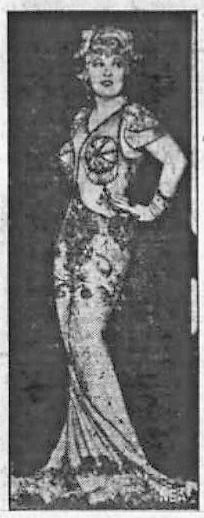From the name of the American film actress Mary Jane ‘Mae’ West (1892-1980), renowned for her generous bust, the informal noun Mae West (plural Mae Wests) denotes an inflatable life jacket, originally as issued to Royal Air Force aviators during the Second World War.
photograph of Mae West, from The News-Palladium (Benton Harbor, Michigan) of Saturday 4th November 1933:

The earliest recorded instance of the common noun Mae West is from The Navy that Flies, published in The Listener (British Broadcasting Corporation, London) on Thursday 11th January 1940:
This squadron of Fleet Air Arm fighters is carrying out, day after day, what I shared with them for a few hours.
First of all a word about the kit. Full flying kit consists of a combination suit like the skin of a teddy bear. On top of that goes a wind-proof combination suit with a high collar lined with fleece. Then comes a life-saving waistcoat. This can be inflated in a few moments by the wearer, and for some obscure reason is known technically as a ‘Mae West’. The parachute harness buckles on over this. It is a cumbersome arrangement to walk about in, but it can be released in a second, and there are moments when it gives its wearer quite a lot of moral support. Lastly there is a flying helmet with earphone attachments, gauntlet gloves, and fleece-lined flying boots.
On Wednesday 6th March 1940, several British newspapers, for example The Evening News (Portsmouth, Hampshire), published a story about the R.A.F., containing the following:
Officers and airmen on early patrols—pilot, navigator, air-gunner, and wireless operator—start their day at this time of year with a call about 5 a.m. They breakfast, and then report in the Operations Room, where the orders relating to patrols, codes and signals for the day must be noted and learned.
They may have to walk some distance to the aircraft in the darkness, often through mud. The crew are laden like Father Christmas, the pilot, for instance, must carry his “Mae West” life jacket, parachute, binoculars, greatcoat, helmet and goggles, vacuum flask and packet of sandwiches. The navigator has, in addition, a large canvas bag containing charts and instruments.
The word Mae West was only one of the R.A.F. slang terms invented during that period, as explained in The Hartford Courant (Hartford, Connecticut) of Sunday 11th May 1941:
New Slang Invention of RAF Pilots
Balloon Barrages Called ‘Rat Traps,’ Life Vests ‘Mae Wests,’ Search-light Is ‘Paul Pry’So active have been the airmen in the present conflict that much of the new slang heard in London is their invention. To the Royal Air Force a searchlight is a “Paul Pry,” unless it diffuses its beams, and then it is a “bearded lady.” Balloon barrages are “rat traps,” life jackets are “Mae Wests,” and the airfield commander is the “stationmaster.” Mechanics are “erks,” short for aircraftsmen, while air-raid warnings are “flaps,” a word borrowed by the army for any kind of scare or alarm. To “scrounge” is to appropriate something for one’s use. The police have another name for it. “Blitzflu” is a sudden but brief attack of influenza.
The following photograph and description are from the Illustrated London News of Saturday 21st November 1942:
THE EQUIPMENT OF THE REAR GUNNER OF A BRITISH HEAVY BOMBER.
On an operational trip he wears: (1) Helmet; (2) Oxygen mask and microphone; (3) Oxygen tube; (4) Inter-communication lead, for telephone conversations among members of the crew; (5) Dog-clips for parachute; (6) Mae West life jacket; (7) Tape ties for Mae West; (8) Quick-release box on parachute harness; (9) Webbing of parachute harness; (10) Fur collar of lambs-wool-lined leather flying jacket.

